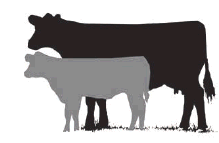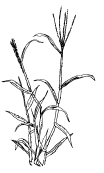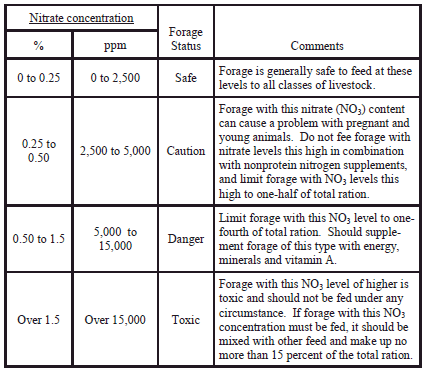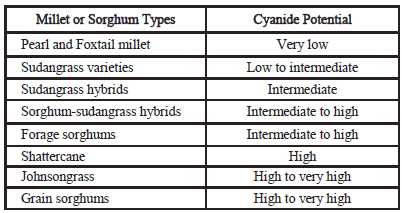

To send a message to an author, click on the author's name at the end of the article.
This Month in Ag Connection | Ag Connection - Other Issues Online
Higher temperatures and humidity levels have arrived with summer. One goal of raising livestock is to keep heat stress at a minimum in order to maximize livestock production. When air temperature reaches 100°F, stocker cattle have a 13.4% increase in maintenance requirements compared to when air temperature is approximately 60°F. Maintenance energy is the energy required for an animal to live and function, and does not include growth, reproduction, lactation, etc. A drop in feed intake typically occurs during summer months with high temperatures and humidity.
Below are some suggestions to maintain intake levels.
Access to readily available water and high quality feeds are especially necessary during hot weather. According to the National Research Council, when temperatures reach 90°F, a lactating cow needs 16.2 gallons of water per day, a 600 lb. growing calf needs 13 gallons/day and a mature bull (1600 lbs.) needs 21 gallons/day.
The body temperature of cattle rises with rumen fermentation (the microbial breakdown of feed within the rumen). While this increase in temperature is a positive thing during the winter, it can hinder production during the summer. The microorganisms within the rumen can more efficiently utilize high quality forages and supplements; thus reducing the amount of heat they produce. When cool season grasses become dormant (KY-31 fescue, Kentucky Blue Grass, etc.) during the summer, forage quality decreases making the rumen microorganisms work harder to digest the lower quality forage; thereby, potentially increasing the temperature within the rumen and in turn, the body temperature of the animal. Quality mineral supplementation with electrolytes may also reduce the effects of heat stress.

Shade is another way to alleviate heat stress. Shade can be provided from natural sources such as trees or by a manmade structure. University of Kentucky has shade recommendations for cattle located online at http://www2.ca.uky.edu/agcomm/pubs/aen/aen99/aen99.pdf.
The University of Missouri Animal Sciences Department has developed an app called, Thermal Aid for iPhones and Android smartphone users. Thermal Aid is a simple, yet functional app, which pulls in live weather data to determine if livestock are being affected by heat stress. The app provides tips to minimize the effects of heat. The website is http://thermalnet.missouri.edu/ThermalAid.
Source: Wendy Flatt, Livestock Specialist
This Month in Ag Connection | Ag Connection - Other Issues Online
Cool-season grass forages, such as tall fescue, are the base of most Missouri grazing systems. Tall fescue is well adapted to Missouri's soil and climate and tends to produce quite well. Tall fescue follows the general growth curve of cool-season grasses, an abundance of growth in the spring and most falls, with limited growth through the mid to late summer. Not only does tall fescue slump during the heat of summer, but most animals are reluctant to graze it during this time period. The majority of tall fescue stands in the state are infected with a fungal endophyte that causes a reduction in weight gain, reproductive performance, and internal body temperature regulation. Because of these factors, producers often turn to forages better suited for summer production.
While several warm-season grasses are available to provide forage production during July and August, many producers often use annual warm-season grasses to fill the slump. Annual warm-season grasses can be used as part of a year round grazing system, in a rotation with row crops, as a smother crop, or even as an emergency forage. While there are several annual forages available for summer grazing, pearlmillet, sorghum-sudangrass hybrids, and crabgrass are most common. These forages may help producers avoid fescue toxicosis; however, some have their disadvantages and potential toxicities as well. When summer weather conditions are adverse, nitrate and prussic acid toxicities can become major concerns for some annual warm-season forages.

The majority of nitrogen absorbed by plant roots is in the nitrate form, and in normal weather conditions, nitrate is rapidly converted into plant proteins. When pearlmillet and sorghum-sudangrass become stressed this conversion stops and nitrates begin to accumulate in the plant. High nitrate accumulation in forages is often the result of a heavy nitrogen application followed by drought conditions. In mild drought conditions, roots continue to absorb nitrate, but plant protein conversion does not take place. In a severe drought, nitrate absorption will cease because of a lack of moisture, but nitrates will be rapidly absorbed following a rain and will likely accumulate to high levels. It can take 7-14 days after a drought-ending rain for nitrates to be metabolized below a toxic level. An energy source is required for nitrate reduction, so extended periods of cloudy weather can contribute to nitrate accumulation, especially when coupled with wet days following a severe drought. Extreme temperatures, both high and low, can also increase nitrate levels.
The term nitrate toxicity is somewhat misleading, because nitrite, not nitrate, is toxic to livestock. In cattle, microorganisms in the rumen reduce nitrate to nitrite, which is then broken down and used by the microorganisms. When nitrite intake is faster than break down, it begins to accumulate and is rapidly absorbed into the blood stream. Nitrite interferes with the ability of blood to transport oxygen and will result in asphyxiation in severe cases. Pregnant, young, or physiologically stressed animals are more susceptible to nitrate toxicity. Symptoms of nitrate toxicity may appear within hours after consumption or be delayed for a few days.
If forages are suspected to contain high nitrates, it is recommended to take a nitrate analysis to determine potential toxicity (see Table 1 below for warning levels for forage nitrate content). Nitrate levels will be highest towards the base of the plant and will tend to be lower in the leaves. If grazing forages with moderate nitrate levels, be sure to feed livestock a dry roughage first to limit intake and use lower stocking rates to avoid overgrazing of the high nitrate stems. To reduce nitrate levels, avoid excessive application of nitrogen fertilizer by using split applications, raise cutter bar to exclude lower parts of the plant stem, and delay harvesting stressed forages for at least one week after favorable weather. Nitrate levels do not decrease after haying, but ensiling can reduce nitrates by 25-50% with adequate fermentation. Be sure to take representative samples of suspect forage prior to feeding.
Prussic acid poisoning is also a potential problem with several sorghum types including sorghum-sudangrass hybrids (see Table 4 for potential cyanide accumulations). Prussic acid is commonly referred to as hydrocyanic acid (HCN) or hydrogen cyanide. In sorghum type plants the HCN is attached to a larger molecule called dhurrin. In a healthy, intact plant the dhurrin is not harmful; however, cells just below the epidermis have an enzyme that is capable of removing HCN from dhurrin when the plant is damaged. The enzyme and dhurrin are intermixed when the plant cells rupture, whether it results from chewing by an animal, a hard freeze, or mechanical such as a mower conditioner. If ingested by the animal, the HCN is immediately absorbed into the blood stream where it prevents oxygen from being transferred to the animal's cells, resulting in asphyxiation on the cellular level. Prussic acid poisoning happens within minutes and usually results in death.
Prussic acid levels are highest in young, rapidly growing plants. Unlike nitrates, HCN is more concentrated in young leaves than in older growth. Any stress which impedes growth will likely increase HCN content. Most cases of prussic acid poisonings are the result of cattle consuming new growth after a drought-ending rain or following the first fall frost. Cattle often ingest the new growth because it is more palatable. Prussic acid levels tend to be higher in areas where high nitrogen fertility is coupled with low phosphorus and potassium levels. Split nitrogen applications will reduce the risk of prussic acid poisoning.
Fortunately, prussic acid is volatile and will dissipate during hay curing or the ensiling process. Before pasturing animals, be sure sorghum-sudangrass has a minimum height of 24 inches. When under drought stress, do not graze until plants have recovered and have at least 24 inches of regrowth. After a killing frost, it is advised to wait 14 days or until leaves turn brown before grazing. If turning cattle into a pasture with potential prussic acid problems, the following is recommended: feed grain or hay before turning animals into pasture to help reduce intake and dilute the amount of HCN consumed; turn in only a few cattle and monitor how they do; ask your local veterinarian to be on hand in case of problems. See MU Guide G4661 for more information. http://extension.missouri.edu/p/G4661
Table 1. Warning levels for forage nitrate content

Table 4. Millet and sorghum types and their potential cyanide accumulations.

Source: Wyatt Miller, Agronomy Specialist
This Month in Ag Connection | Ag Connection - Other Issues Online
Sweet corn can be planted in the garden on different dates throughout the spring to enjoy fresh corn on the cob for several weeks. Sweet corn hybrids are available in differing maturities, ranging from 65 to 90 days. Knowing when to harvest sweet corn can be a bit tricky. When the silks begin to dry out and turn brown it is about time to harvest sweet corn. Sweet corn ears should be picked during the "milk stage" when the kernels are fully formed but not fully mature, which occurs approximately 20 days after the appearance of the first silk strands. The kernels are smooth and plump and the juice in the kernel appears milky when punctured with a thumbnail. Sweet corn remains in the milk stage less than a week. Other signs to look for are drying and browning of the silks, fullness of the tip kernels, and firmness of unhusked ears.
Okra is a warm-season vegetable from the same family as hollyhock, rose of Sharon and hibiscus. The immature pods are used for canning, soups, stews or can be fried or boiled. The pods should be picked, usually cut, while tender and immature, typically, 2 to 3 inches long for most varieties. Okra needs to be picked often, at least every other day. Large pods rapidly become tough and woody. Okra plants have short hairs which may irritate skin; therefore, wear gloves and long sleeves to harvest okra. Okra plants are productive and grow and bear pods until frost. Four or five plants produce enough pods to feed one family.
Green beans should be harvested when the pods are firm, crisp, and fully elongated, but before the seed within the pod has developed significantly. Beans should be picked after the dew has dried to prevent the spread of disease. Be careful not to break the stems or branches, which are brittle on most bean varieties. The bean plant continues to form new flowers and produces more beans if pods are continually removed before the seeds mature.
Cucumbers can be picked at any stage of development before the seeds become hard. The optimal size depends upon the use and variety. They may be picked when they are no more than 2 inches long for pickles, 4 to 6 inches long for dill pickles, and 6 to 8 inches long for slicing varieties. Cucumbers are of highest quality when uniformly green, firm, and crisp. Do not allow cucumbers to turn yellow. Remove overripe or yellow fruits from the vine to allow young fruits to continue to develop. The cucumber fruit grows rapidly to harvest size and should be picked at least every other day.

Tomatoes should be picked when firm and fully colored. Tomatoes need good foliage cover to prevent the fruit from getting sunburn also known as yellow shoulder. Yellow shoulder is a common disorder of tomatoes due to heat stress. High temperatures, (air temperature of 90°F or more), can affect the ripening process. The softening process is accelerated and color development is retarded, reducing the quality of tomatoes. During the hot days of summer, tomatoes should be picked every day or two. Refrigeration is not recommended after harvest, instead leave tomatoes at room temperature for best quality and flavor. Before a killing freeze, harvest all green mature fruit that is desired for later use in the fall. Wrap the tomatoes individually in paper and store at 60 to 65°F. They will continue to ripen over the next several weeks. Whole plants may be pulled up and hung in sheltered locations, where the fruit will continue to ripen.
For more information on harvesting vegetables see MU guide 6226 at http://extension.missouri.edu/p/G6226.
Source: Jennifer Schutter, Horticulture Specialist
Publishing Information
Ag Connection is published monthly for Northeast and Central areas of Missouri producers and is supported by the University of Missouri Extension, the Missouri Agricultural Experiment Station, and the MU College of Agriculture, Food and Natural Resources. Managing Editor: Mary Sobba.